Gibilisco S. Teach Yourself Electricity and Electronics
Подождите немного. Документ загружается.

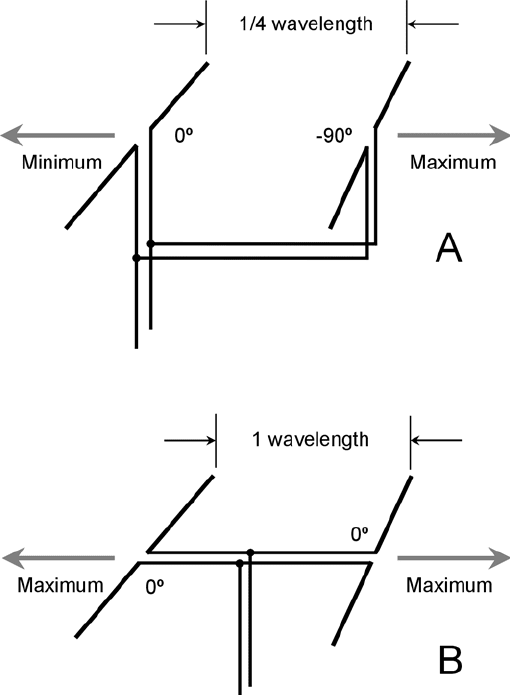
Longwire
A wire antenna measuring λ or more, and fed at a high-current point or at one end, is a longwire an-
tenna. A longwire antenna offers gain over a half-wave dipole. As the wire is made longer, the main
lobes get more nearly in line with the antenna, and their amplitudes increase. The gain is a function
of the length of the antenna; the longer the wire, the greater the gain. A longwire antenna must be
as straight as possible for proper operation.
Broadside Array
Figure 27-9 shows the geometric arrangement of a broadside array. The driven elements can each
consist of a single radiator, as shown in the figure, or they can consist of more complex antennas
with directive properties. In any case, all the elements are identical. If a reflecting screen is placed
behind the array of dipoles in Fig. 27-9, the system is known as a billboard antenna. The directional
properties depend on the number of elements, whether or not the elements have gain themselves,
and on the spacing among the elements. In general, the larger the number of elements, the greater
the forward gain, and the greater the f/b and f/s ratios.
Phased Arrays 481
27-8 At A, a unidirectional
phased system. At B,
a bidirectional phased
system.
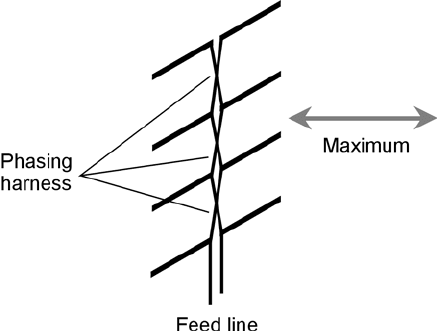
Parasitic Arrays
Parasitic arrays are used at frequencies ranging from approximately 5 MHz into the microwave range
for obtaining directivity and forward gain. Examples include the Yagi antenna and the quad antenna.
Concept
A parasitic element is a conductor that forms an important part of an antenna system, but is not di-
rectly connected to the feed line. Parasitic elements operate by means of EM coupling to the driven
element. When gain is produced in the direction of the parasitic element, the element is a director.
When gain is produced in the direction opposite the parasitic element, the element is a reflector. Di-
rectors are a few percent shorter than the driven element; reflectors are a few percent longer.
Yagi
The Yagi antenna, sometimes called a “beam,” is an array of parallel, straight elements. A two-
element Yagi is formed by placing a director or a reflector parallel to, and a specific distance away
from, a single λ/2 driven element. The optimum spacing for a driven-element/director Yagi is 0.1λ
to 0.2λ, with the director tuned 5 percent to 10 percent higher than the resonant frequency of the
driven element. The optimum spacing for a driven-element/reflector Yagi is 0.15λ to 0.2λ, with the
reflector tuned 5 percent to 10 percent lower than the resonant frequency of the driven element.
The gain of a well-designed two-element Yagi is approximately 5 dBd.
A Yagi with one director and one reflector, along with the driven element, increases the gain and
f/b ratio compared with a two-element Yagi. An optimally designed three-element Yagi has approxi-
mately 7 dBd gain. An example is shown in Fig. 27-10. (This drawing should not be used as an en-
gineering blueprint.)
The gain, f/b ratio, and f/s ratio of a properly designed Yagi antenna all increase as elements are
added. This is usually done by placing extra directors in front of a three-element Yagi. Each director
is slightly shorter than its predecessor.
Quad
A quad antenna operates according to the same principles as the Yagi, except full-wavelength loops
are used instead of straight half-wavelength elements.
482 Antennas
27-9 A broadside array.
The elements are all
fed in phase.
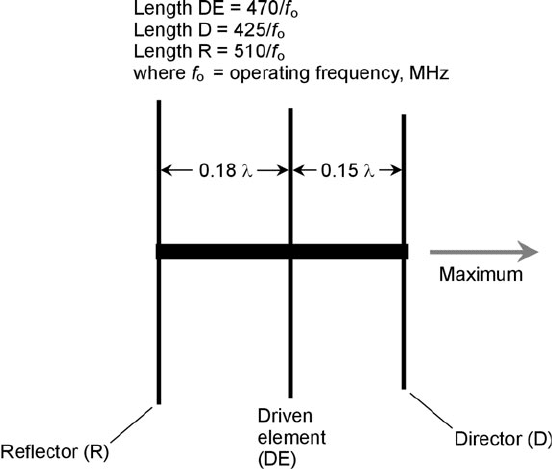
A two-element quad can consist of a driven element and a reflector, or it can have a driven ele-
ment and a director. A three-element quad has one driven element, one director, and one reflector.
The director has a perimeter of 0.95λ to 0.97λ, the driven element has a perimeter of exactly λ, and
the reflector has a perimeter of 1.03λ to 1.05λ. These dimensions, as all antenna element dimen-
sions, are electrical dimensions (taking the velocity factor of wire or tubing into account), and not
free-space dimensions.
Additional directors can be added to the basic three-element quad design to form quads having
any desired numbers of elements. The gain increases as the number of elements increases. Each suc-
ceeding director is slightly shorter than its predecessor. Long quad antennas are practical at frequen-
cies above 100 MHz. At lower frequencies, their construction tends to be unwieldy.
Antennas for Ultrahigh and
Microwave Frequencies
At ultrahigh frequencies (UHF) and microwave frequencies, high-gain antennas are reasonable in
size because the wavelengths are short.
Waveguides
In Chap. 25, waveguides were briefly mentioned as an option for feeding antenna systems at UHF
and microwave frequencies. Here’s a little more about them.
A waveguide is a hollow metal pipe having a rectangular or circular cross section. The EM field
travels down the pipe, provided that the wavelength is short enough (or the cross-sectional dimen-
sions of the pipe are large enough). In order to efficiently propagate an EM field, a rectangular wave-
guide must have height and width that both measure at least 0.5λ, and preferably more than 0.7λ.
A circular waveguide should be at least 0.6λ in diameter, and preferably 0.7λ or more.
Antennas for Ultrahigh and Microwave Frequencies 483
27-10 A three-element Yagi
antenna. Dimensions
are discussed in the
text.
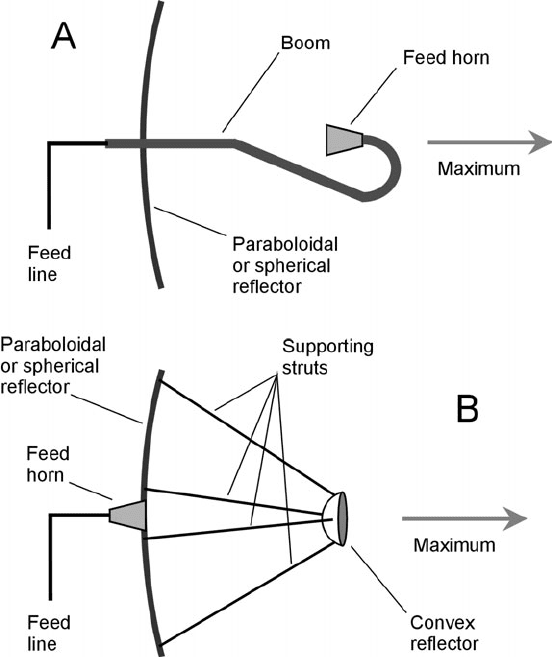
The characteristic impedance (Z
o
) of a waveguide varies with frequency. In this sense, it differs
from coaxial or parallel-wire lines, whose Z
o
values are generally independent of the frequency.
A properly installed and well-maintained waveguide is an exceptional transmission line because
dry air has practically no loss, even at UHF and microwave frequencies. But it is important that the
interior of a waveguide be kept free from dirt, dust, insects, spiderwebs, and condensation. Even a
small obstruction can seriously degrade the performance and cause the waveguide to become lossy.
The main limitation of a waveguide, from a practical standpoint, is inflexibility. You can’t run
a waveguide from one point to another in a haphazard fashion, as you can do with coaxial cable.
Bends or turns in a waveguide present a particular problem, because they must be made gradually.
Installing a waveguide for a UHF or microwave antenna is a little like putting in the conduit for a
new electrical circuit in a home or business. It’s a significant construction project!
Waveguides are impractical for use at frequencies below approximately 300 MHz, because the
required cross-sectional dimensions become prohibitively large.
Dish
A dish antenna must be correctly shaped and precisely aligned. The most efficient shape, espe-
cially at the shortest wavelengths, is a paraboloidal reflector. However, a spherical reflector, having
484 Antennas
27-11 Dish antennas with
conventional feed
(A) and Cassegrain
feed (B).
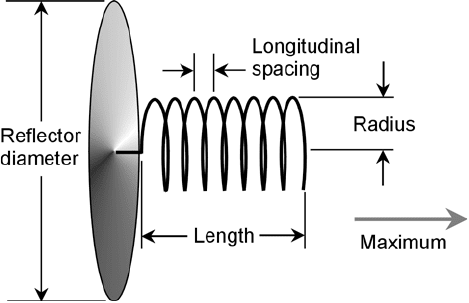
the shape of a section of a sphere, can also work well. The feed system consists of a coaxial line or
waveguide from the receiver and/or transmitter, and a horn or helical driven element at the focal
point of the reflector. Conventional dish feed is shown in Fig. 27-11A. Cassegrain dish feed is shown
in Fig. 27-11B.
The larger the diameter of the reflector in wavelengths, the greater the gain, the f/b ratio, and
the f/s ratio, and the narrower the main lobe. A dish antenna must be at least several wavelengths in
diameter for proper operation. The reflecting element can be sheet metal, a screen, or a wire mesh.
If a screen or mesh is used, the spacing between the wires must be a small fraction of a wavelength.
Helical
A helical antenna is a circularly polarized, high-gain, unidirectional antenna. A typical helical antenna
is shown in Fig. 27-12. The reflector diameter should be at least 0.8λ at the lowest operating fre-
quency. The radius of the helix should be approximately 0.17λ at the center of the intended oper-
ating frequency range. The longitudinal spacing between helix turns should be approximately 0.25λ
in the center of the operating frequency range. The overall length of the helix should be at least λ at
the lowest operating frequency. A helical antenna can provide about 15 dBd forward gain. Helical
antennas are sometimes used in space communications systems.
Corner Reflector
A corner reflector, employed with a λ/2 dipole driven element, is illustrated in Fig. 27-13. This pro-
vides some gain over a λ/2 dipole by itself. The reflector is made of wire mesh, screen, or sheet metal.
The flare angle of the reflecting element is approximately 90°. Corner reflectors are widely used in
terrestrial communications at UHF and microwave frequencies. Several λ/2 dipoles can be fed in
phase and placed along a common axis with a single, elongated reflector, forming a collinear corner
reflector array.
Horn
The horn antenna is shaped like a squared-off trumpet or trombone horn. It provides a unidirec-
tional radiation and response pattern, with the favored direction coincident with the opening of the
horn. The feed line is a waveguide that joins the antenna at the narrowest point (throat) of the horn.
Antennas for Ultrahigh and Microwave Frequencies 485
27-12 A helical antenna
with a flat reflector.
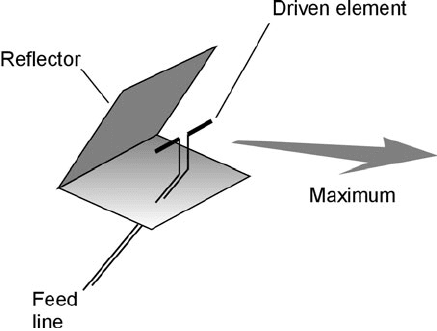
Horns are sometimes used all by themselves, but they are also used to feed large dish antennas. This
optimizes the f/s ratio by minimizing extraneous radiation and response that occurs if a dipole is
used as the driven element for the dish.
Safety
Antennas should never be placed in such a way that they can fall or blow down on power lines. Also,
it should not be possible for power lines to fall or blow down on an antenna.
Wireless equipment having outdoor antennas should not be used during thundershowers, or
when lightning is anywhere in the vicinity. Antenna construction and maintenance should never be
undertaken when lightning is visible or thunder can be heard, even if a storm appears to be many
miles away. Ideally, antennas should be disconnected from electronic equipment, and connected to
a substantial earth ground, at all times when the equipment is not in use.
Tower and antenna climbing is a job for professionals. Under no circumstances should an inex-
perienced person attempt to climb such a structure.
Indoor transmitting antennas can expose operating personnel to EM field energy. The extent of
the hazard, if any, posed by such exposure has not been firmly established. However, there is suffi-
cient concern to warrant checking the latest publications on the topic.
For detailed information concerning antenna safety, consult a professional antenna engineer
and/or a comprehensive text on antenna design and construction.
Quiz
Refer to the text in this chapter if necessary. A good score is at least 18 correct. Answers are in the
back of the book.
1. Imagine a center-fed, straight wire antenna in free space, whose length can be varied at will.
At which of the following lengths is the radiation resistance at the feed point the highest?
(a) λ/4
(b) λ
486 Antennas
27-13 A corner reflector
with a dipole as the
driven element.
(c) λ/3
(d) λ/2
2. What is the approximate length, in meters (m), of a center-fed, λ/2 wire antenna at a
frequency of 18.1 MHz? Assume the velocity factor is typical for wire.
(a) 7.90 m
(b) 8.29 m
(c) 13.6 m
(d) 25.9 m
3. What is the approximate height, in feet (ft), of a ground-mounted, λ/4 vertical antenna,
made of aluminum tubing, at a frequency of 7.025 MHz? Assume the velocity factor is 92
percent.
(a) 64.43 ft
(b) 32.22 ft
(c) 19.64 ft
(d) 9.822 ft
4. In order to obtain reasonable efficiency with a λ/4 vertical antenna mounted over poorly
conducting soil at a frequency of 10 MHz, it is necessary to
(a) make the antenna out of large-diameter aluminum or copper tubing.
(b) suspend the antenna from a kite or balloon.
(c) feed the antenna with a waveguide.
(d) minimize the loss resistance by installing numerous ground radials.
5. A driven element in a parasitic array is
(a) grounded for dc.
(b) a loop with a circumference of λ/2.
(c) connected to the feed line.
(d) a straight length of wire.
6. In a zepp antenna, feed-line radiation can be minimized by
(a) using the antenna only at frequencies where its length is a whole-number multiple of λ/2.
(b) using the antenna only at frequencies where its length is a whole-number multiple of λ/4.
(c) using the antenna only at frequencies where its length is an even-number multiple of
λ/10.
(d) using the antenna only at frequencies where its length is an odd-number multiple of λ/4.
7. Consider a single-turn, closed loop having a circumference of 95 ft. Suppose this loop is
circular, lies entirely in a single plane, is fed with open-wire transmission line and an antenna
tuner, and is operated at 10 MHz. The maximum radiation and response for this loop can be
expected to occur
(a) in the plane containing the loop.
(b) along a line perpendicular to the plane containing the loop.
Quiz 487
(c) along a line coinciding with the path of the feed line.
(d) equally in all directions in three-dimensional space.
8. Suppose an antenna system has a radiation resistance of 40 Ω at 8.5 MHz. What is the
efficiency of this system?
(a) 25 percent
(b) 40 percent
(c) 80 percent
(d) Impossible to determine without more information
9. Suppose an antenna system has a radiation resistance of 40 Ω and a loss resistance of 10 Ω.
What is the efficiency of this system?
(a) 25 percent
(b) 40 percent
(c) 80 percent
(d) Impossible to determine without more information
10. The null in a loopstick antenna exists
(a) in the plane perpendicular to the coil axis.
(b) in the line that coincides with the coil axis.
(c) at a 45° angle with respect to the coil axis.
(d) nowhere, because a loopstick is an isotropic antenna.
11. As elements are added to a properly designed Yagi antenna,
(a) the forward gain decreases.
(b) the f/b ratio decreases.
(c) the f/s ratio increases.
(d) None of the above apply.
12. When the radiation resistance in an antenna system represents most of the total system
resistance,
(a) the system can be expected to have high loss.
(b) the system can be expected to have high efficiency.
(c) the system can be expected to have a high f/s ratio.
(d) the system can be expected to have a high f/b ratio.
13. What state of affairs is optimal in a waveguide?
(a) A colony of spiders inside
(b) A cross-sectional measurement of less than λ/4
(c) Operation at frequencies below 3 MHz
(d) None of the above
488 Antennas
14. Consider a single-turn, closed loop having a circumference of 65 ft. Suppose this loop is
circular, lies entirely in a single plane, is fed with open-wire transmission line and an antenna
tuner, and is operated at 7 MHz. The maximum radiation and response for this loop can be
expected to occur
(a) in the plane containing the loop.
(b) along a line perpendicular to the plane containing the loop.
(c) along a line coinciding with the path of the feed line.
(d) equally in all directions in three-dimensional space.
15. Suppose the total resistance in an antenna system is 80 Ω, and the loss resistance is 20 Ω. The
efficiency of the system is
(a) 80 percent.
(b) 75 percent.
(c) 25 percent.
(d) impossible to determine without more information.
16. In a parasitic array, a director is usually
(a) tuned to a slightly higher frequency than the driven element.
(b) connected to a system of ground radials.
(c) a closed loop that is grounded for RF.
(d) a straight length of wire or tubing.
17. A J pole is a modified form of
(a) ground-plane antenna.
(b) folded dipole antenna.
(c) quad antenna.
(d) zepp antenna.
18. Which of the following antenna types is well suited to use with parallel-wire transmission
line?
(a) The ground plane
(b) The ground-mounted vertical
(c) The folded dipole
(d) None of the above
19. Which of the following antenna types is not designed for transmitting at 10 GHz?
(a) A horn antenna
(b) A dish antenna
(c) A zepp antenna
(d) A helical antenna
Quiz 489
20. A vertical antenna measuring λ/2 in height does not require a ground system with low
resistance because
(a) its loss resistance is high.
(b) its radiation resistance is low.
(c) its main lobe is sharp.
(d) None of the above apply.
490 Antennas
